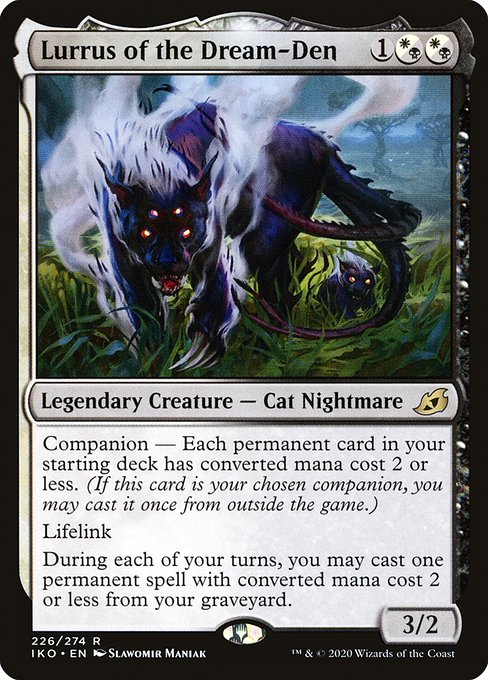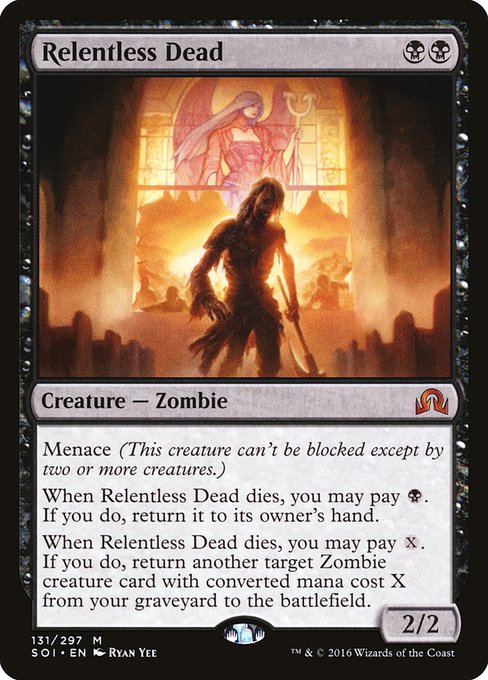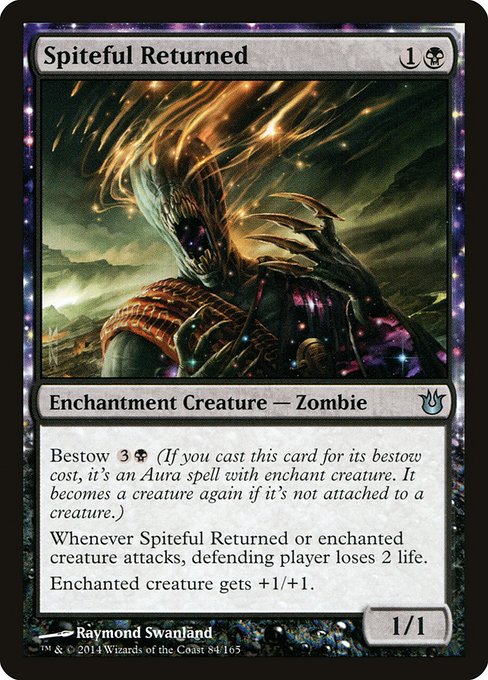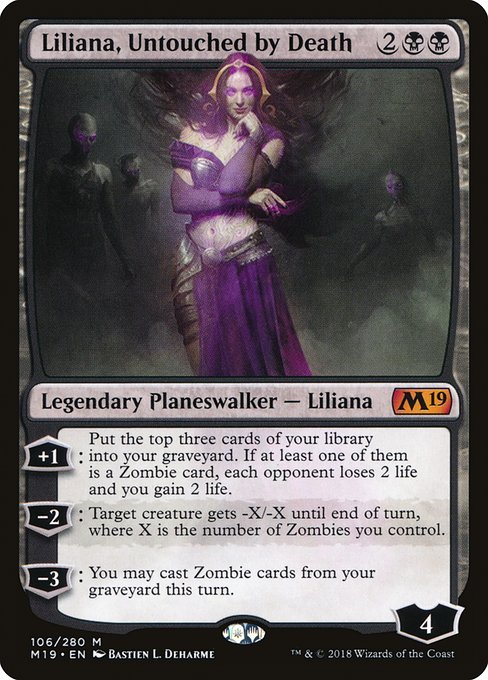You should be playing Lurrus more often.

I know: you’re playing Lurrus constantly. I get it. I am too. But you should be playing her even more than that. You should wake up with “tap three, fetch Lurrus” on your lips. You should adopt a cat from your local shelter and name it Lurry. You should try to splash her in a Temur deck. Rakdos Aggro in Modern, Vampires in Historic, Pioneer Burn, Karlov of the Ghost Council in Commander.
When you’re building an untested deck, your first question should be “how do I warp the deck to accommodate Lurrus?” She’s a Phyrexian Arena who attacks for three, a Palace Siege with both modes active, an extra card in your hand at all times, an absolute powerhouse. Lurrus is one of the most-commonly played threats/engines in Modern, banned in Legacy and Vintage, subsequently unbanned in Vintage, a staple in Historic, and a pillar of the current underdog format, Pioneer. And despite all that, she’s still not respected enough.
My thesis here is that Lurrus is not seeing as much play in Pioneer as they should be. That’s to be expected—Pioneer itself isn’t seeing as much play as it should. Pioneer Challenger decks, despite not rotating like the Standard Challenger decks, are languishing on shelves and selling at huge markdowns from online retailers. Pioneer staples are stagnant in price (thus it’s the perfect time to snag them for savvy players). Magic Online and Arena have kept Standard, Modern, Limited, and digital formats alive, and Commander players would still be having power level discussions over tin can telephones if the bombs fell, so these formats have weathered the pandemic well. This leaves the fringier formats—Premodern, Old School, Oathbreaker, and Pioneer—out in the cold.
I have faith that Pioneer will bounce back. Recent reprints like Thalia, Guardian of Thraben, Runed Halo, and Lotus Cobra imply that Wizards wants to buttress the format going forward, even if Pioneer Masters is on hiatus. The Companions are a hurdle for the format—Lurrus, Yorion, and Jegantha all see consistent play at top levels—but I don’t see Wizards admitting fault again with the mechanic and banning them.
So this seems like the perfect opportunity to build for the format. While most of the Magic attention is focused elsewhere, we can lay the groundwork for something new and potent. Currently, the best place for Lurrus in Pioneer is Burn/Red Deck Wins, buying back dead Dreadhorde Arcanists and Eidolons and getting the last couple of points in with Viashino Pyromancer. It’s also great in Rakdos Aggro/Sacrifice, letting you Unearth Kroxa for a pittance every turn. The combo of Midnight Hunt and Crimson Vow has me taking a different tack, though.

Pioneer is sometimes called a “zombie format,” so how about we take that literally? Zombies has been at the fringe of Pioneer playability—we’re missing the Modern Lords, but we do have a myriad two-drops that play well with Lurrus. Suitably, this is basically a rotten version of Orzhov Humans, but your mana is better and your resilience is greater to board wipes and removal. You can’t keep a good Zombie down, particularly when they keep getting bought back by everyone’s most favored/vehemently hated Nightmare Cat.
Pioneer Zombies, Companion Lurrus
| Creatures (29) 4 Cryptbreaker 4 Dread Wanderer 4 Champion of the Perished 4 Wight 2 Spiteful Returned 3 Tainted Adversary 4 Relentless Dead 4 Graveyard Marshal Spells (8) 4 Thoughtseize 1 Necromancer's Stockpile 3 Dark Salvation | Lands (23) 4 Mutavault 2 Hive of the Eye Tyrant 2 Castle Locthwain 15 Swamp Sideboard (15) 1 Lurrus of the Dream-Den 3 Graf Reaver 4 Rotten Reunion 3 Silent Gravestone 2 Infinite Obliteration 2 Necromentia |
Our curve starts with twelve one-drops who work well together and allow us to maximize Thoughtseize perfectly on turn two. Relentless Dead is the centerpiece of the deck and the best reason to stay mono black. In conjunction with Lurrus, Relentless Dead allows you to loop your best Zombies back while starting the beatdown early. The deck’s curve is low, but we can maximize our mana every turn by buying back dead soldiers and tailoring our quirkier Zombies like Relentless Dead and Tainted Adversary—a decent two drop that’s even better late game with Lurrus.
Thanks to Lurrus, our curve is absurdly low, allowing us to cash in late-drawn lands for Zombie tokens with Cryptbreaker and activate Hive of the Eye Tyrant or Mutavault. Unlike many tribal decks in Pioneer, we can’t piggyback off of lords with Mutavault, but it’s still useful for Cryptbreaker and Dark Salvation and for getting in a couple of damage if they deal with your horde.

I’ve been most impressed by Spiteful Returned, who attacks fearlessly early on and then can be recast with Lurrus or stapled onto a Mutavault or Champion later on. It’s been twenty years since he was a staple, but I would adore a reprint of Withered Wretch to combat format boogeyman Izzet Phoenix. In the meantime, we’ll have to be content with a sideboarded Silent Gravestone and Rotten Reunion. The sideboard is hyperfocused on Izzet Phoenix, so adapt as necessary. Graf Reaver has overperformed as a Narset killer that can be recast multiple times a turn with Lurrus, potentially sniping several planeswalkers in succession.
We could potentially splash for Collected Company—it’s basically free with Slitherbore Pathway and Overgrown Tomb—but I find we’re better off spending our mana on recursion and threats. With twenty-nine Zombies, it’s not likely that you whiff off a Company, though, so it’s worth exploring. Similarly, splashing Red for Dreadhorde Arcanist is plausible—he doesn’t fight any of our strategies and can flash back Thoughtseize or, hilariously, Dark Salvation. As I continue to explore the archetype, I may rely on one of these microstrategies, but I wanted to fully nail mono black Zombies before branching out.
In building around Lurrus, we lose Diregraf Colossus, Headless Rider, Rotting Regisaur, Liliana, the Last Hope, and Kalitas, Traitor of Ghet. We also lose out on the Zombie Lords in Pioneer—Death Baron and Risen Executioner. The loss of none of these is insurmountable (although, frankly, Headless Rider would be very nice).

More troubling initially is the fact that we can’t run Liliana, Untouched by Death, which seems like the lynchpin of a Zombie deck. The thing is, having tested Zombies extensively in Modern, four mana is a huge ask, and she looks better on paper than she actually plays. Her loss is more thematic than ludic. Likewise, I elected to eschew Lazotep Reaver. While creating two Zombie bodies for Cryptbreaker is powerful, it’s a more Lord-oriented style of card. That deck is a valid way to develop Zombies in Pioneer, but we’re aiming for a stable, tenacious long game rather than an aggressive rush.
I’m having a blast with Pioneer, alternating between Lotus Field and more straightforward aggro decks like Lurrus Zombies. I adore the Lotus Field deck because it proves that, like crabs, Magic will always evolve to a solitaire-playing combo deck. As someone who’s Exhumed Ulamog’s Crusher in Pauper, Donated Illusions of Grandeur in Extended, and Inverted into Thassa’s Oracle in Pioneer, there’s a thrilling antagonism, the griefer’s delight, to a combo deck, particularly in how they pop up against the odds and in opposition to the banning of other combo decks.
Inverter, Kethis, Lotus Field—these are complex, carefully crafted decks that demand total knowledge of the deck’s possible interactions and lines of play. Zombies, however, only demand a curve and enough space to land a couple of quick shamblers before your opponent has their defenses up and, in the case of this deck, the resilience of Lurrus. It’s a nice break from taxing combo decks, and it has legs: they may be rotten, rigor mortis’ed legs, but legs nonetheless.
A lifelong resident of the Carolinas and a graduate of the University of North Carolina, Rob has played Magic since he picked a Darkling Stalker up off the soccer field at summer camp. He works for nonprofits as an educational strategies developer and, in his off-hours, enjoys writing fiction, playing games, and exploring new beers.

